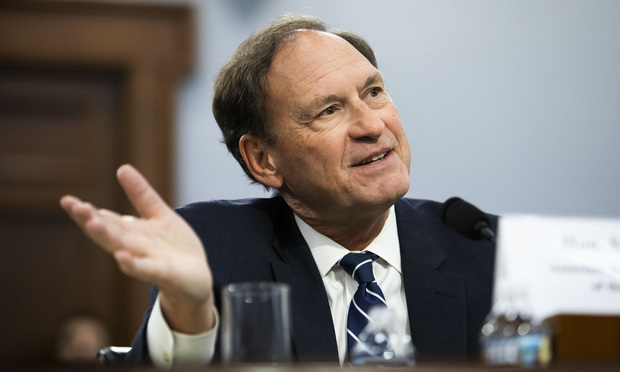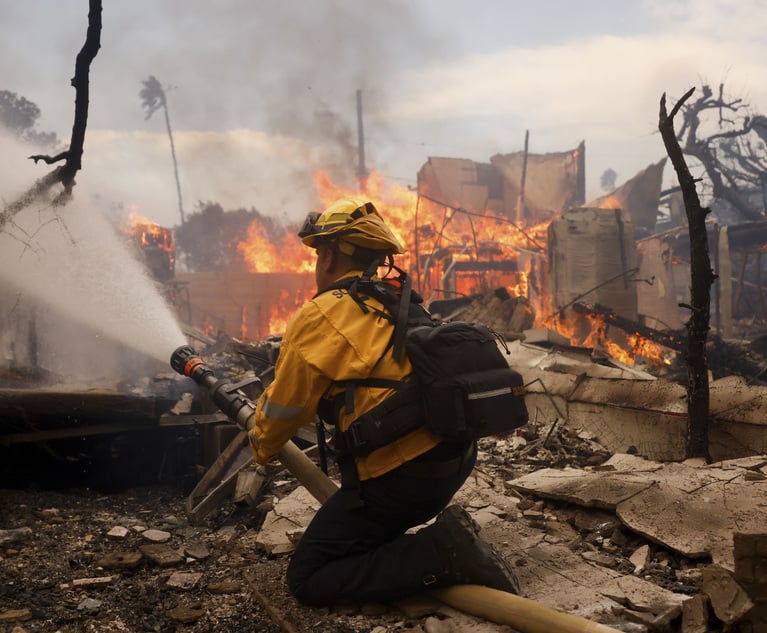Gorsuch and Alito Question NY's 'Herculean' Effort to Prevent Gun Ruling
Justices Sonia Sotomayor, Ruth Bader Ginsburg and Elena Kagan pushed back at comments from Justices Samuel Alito Jr. and Neil Gorsuch that suggested the court could still issue a ruling on a defunct New York firearm regulation.
December 02, 2019 at 02:32 PM
5 minute read
 Justice Alito testifying in 2019. Credit: Diego M. Radzinschi / ALM
Justice Alito testifying in 2019. Credit: Diego M. Radzinschi / ALM
Justices Neil Gorsuch and Samuel Alito Jr. on Monday appeared to strive to save the U.S. Supreme Court's first major gun-rights case in nearly a decade from disappearing without a ruling on the scope of the Second Amendment.
Groups supporting broad firearm rights, critical of how lower courts have applied the Second Amendment, have urged the court to use the case to announce a tough standard or test that governments must meet in order for regulations to be upheld as constitutional.
Alito and Gorsuch dominated questioning of New York City Law Department's chief of appeals Richard Dearing, who argued there no longer was a live controversy for the justices to resolve in the case New York State Rifle & Pistol Association v. City of New York. Before the case was argued, New York scrapped its rule that set restrictions on the transport of firearms outside the city limits.
Justices Sonia Sotomayor, Ruth Bader Ginsburg and Elena Kagan pushed back at comments by Alito and Gorsuch that suggested the court could still issue a ruling on the New York regulations.
Justices Clarence Thomas and Brett Kavanaugh did not ask any questions during the arguments. Kavanaugh's silence was somewhat surprising given his strong dissenting opinion in a 2011 Second Amendment case when he sat on the U.S. Court of Appeals for the D.C. Circuit. In that ruling, Kavanaugh wrote a lengthy dissent explaining why he would strike down the District of Columbia's firearm registration requirement and ban on semi-automatic rifles.
The mootness issue surrounding the case arose after the justices agreed to review the New York case. The defunct restrictions limited the transport of guns—unloaded and locked in a container—from the home to any of seven designated shooting ranges inside the city. License holders could not transport their guns to shooting ranges or second homes outside of the city.
After the city eliminated those restrictions, the New York General Assembly, amending state law, said premises-license holders could transport their handguns to any location where they are lawfully authorized to have and possess such a weapon.
During arguments Monday, Gorsuch called the city's amended ordinance "herculean, late-breaking efforts to moot the case." Alito described it as a "quite extraordinary step" to attempt to moot the challenge.
But Ginsburg, questioning Kirkland & Ellis partner Paul Clement, lead counsel for the New York State Rifle & Pistol Association, said the new state law blocks whatever the city attempted to do. "What's left of this case?" she asked. "Petitioners have gotten all that they sought."
Whether the challengers received all they asked for in their lawsuit was at the heart of the mootness arguments. Clement contended that if they had prevailed in the lower courts, they would have sought an injunction protecting against any future prosecutions for violations of the old law and other collateral consequences of that law.
Clement and Deputy Solicitor General Jeffrey Wall also argued that the challengers still might be able to ask for damages for economic losses flowing from the defunct regulation. But Dearing drew support from Ginsburg when he countered that the high court had never used a late damages request to save a case from mootness.
The challengers also contend the city's old law violates the Second Amendment, the commerce clause and the right to travel. The U.S. Court of Appeals for the Second Circuit affirmed a district court ruling in favor of the city on all counts.
On the merits of the constitutional challenge to the defunct city restrictions, Clement and Wall urged the high court to adopt "text, history and tradition" as the constitutional test for gun regulations.
Clement said the Second Amendment right to keep and bear arms is not strictly limited to the premises.
Wall argued the justices' landmark Second Amendment ruling in 2008—District of Columbia v. Heller—said to start the constitutional analysis with text, history and tradition. History answers the question about the city's restrictions because, he claimed, "There is no historical analog" for those restrictions.
 Supreme Court Justice Sonia Sotomayor speaking June 8, 2018. Credit: Diego M. Radzinschi / ALM
Supreme Court Justice Sonia Sotomayor speaking June 8, 2018. Credit: Diego M. Radzinschi / ALMBut Sotomayor called that test a "made-up new standard." Heller, she added, was very careful to say: "We treat [the Second Amendment] as any other constitutional provision."
Chief Justice John Roberts Jr. on Monday asked few questions during arguments in the New York case and he gave no indication of where he might stand on the mootness and merits issues.
More than 40 amicus briefs have been filed by a broad range of gun rights groups, civil rights groups, victims of gun violence and others. Major U.S. law firms, representing various friend-of-the-court parties, were largely supportive of New York's regulatory scheme for firearms.
Wall argued for the Justice Department likely because Noel Francisco, the U.S. solicitor general, had recused. His former law firm, Jones Day, filed a brief on behalf of the Giffords Law Center to Prevent Gun Violence.
Read more:
Alito Alone Wanted Court to Check Climate Scientist's Defamation Claim
Justice Gorsuch Raises Key Question Against Trump's Move to Rescind DACA
Supreme Court Turns Down Remington's Push to Stop Connecticut Case
Justices, With Kavanaugh Seated, End 9-Year Avoidance of Gun Regulations
Clarence Thomas, in Dissent, Asserts Gun Rights Aren't 'Favored' at High Court
This content has been archived. It is available through our partners, LexisNexis® and Bloomberg Law.
To view this content, please continue to their sites.
Not a Lexis Subscriber?
Subscribe Now
Not a Bloomberg Law Subscriber?
Subscribe Now
NOT FOR REPRINT
© 2025 ALM Global, LLC, All Rights Reserved. Request academic re-use from www.copyright.com. All other uses, submit a request to [email protected]. For more information visit Asset & Logo Licensing.
You Might Like
View All
'Religious Discrimination'?: 4th Circuit Revives Challenge to Employer Vaccine Mandate
2 minute read
4th Circuit Revives Racial Harassment Lawsuit Against North Carolina School District
3 minute read

DOJ, 10 State AGs File Amended Antitrust Complaint Against RealPage and Big Landlords
4 minute readLaw Firms Mentioned
Trending Stories
- 1Court Rejects San Francisco's Challenge to Robotaxi Licenses
- 2'Be Prepared and Practice': Paul Hastings' Michelle Reed Breaks Down Firm's First SEC Cybersecurity Incident Disclosure Report
- 3Lina Khan Gives Up the Gavel After Contentious 4 Years as FTC Chair
- 4Allstate Is Using Cell Phone Data to Raise Prices, Attorney General Claims
- 5Epiq Announces AI Discovery Assistant, Initially Developed by Laer AI, With Help From Sullivan & Cromwell
Who Got The Work
J. Brugh Lower of Gibbons has entered an appearance for industrial equipment supplier Devco Corporation in a pending trademark infringement lawsuit. The suit, accusing the defendant of selling knock-off Graco products, was filed Dec. 18 in New Jersey District Court by Rivkin Radler on behalf of Graco Inc. and Graco Minnesota. The case, assigned to U.S. District Judge Zahid N. Quraishi, is 3:24-cv-11294, Graco Inc. et al v. Devco Corporation.
Who Got The Work
Rebecca Maller-Stein and Kent A. Yalowitz of Arnold & Porter Kaye Scholer have entered their appearances for Hanaco Venture Capital and its executives, Lior Prosor and David Frankel, in a pending securities lawsuit. The action, filed on Dec. 24 in New York Southern District Court by Zell, Aron & Co. on behalf of Goldeneye Advisors, accuses the defendants of negligently and fraudulently managing the plaintiff's $1 million investment. The case, assigned to U.S. District Judge Vernon S. Broderick, is 1:24-cv-09918, Goldeneye Advisors, LLC v. Hanaco Venture Capital, Ltd. et al.
Who Got The Work
Attorneys from A&O Shearman has stepped in as defense counsel for Toronto-Dominion Bank and other defendants in a pending securities class action. The suit, filed Dec. 11 in New York Southern District Court by Bleichmar Fonti & Auld, accuses the defendants of concealing the bank's 'pervasive' deficiencies in regards to its compliance with the Bank Secrecy Act and the quality of its anti-money laundering controls. The case, assigned to U.S. District Judge Arun Subramanian, is 1:24-cv-09445, Gonzalez v. The Toronto-Dominion Bank et al.
Who Got The Work
Crown Castle International, a Pennsylvania company providing shared communications infrastructure, has turned to Luke D. Wolf of Gordon Rees Scully Mansukhani to fend off a pending breach-of-contract lawsuit. The court action, filed Nov. 25 in Michigan Eastern District Court by Hooper Hathaway PC on behalf of The Town Residences LLC, accuses Crown Castle of failing to transfer approximately $30,000 in utility payments from T-Mobile in breach of a roof-top lease and assignment agreement. The case, assigned to U.S. District Judge Susan K. Declercq, is 2:24-cv-13131, The Town Residences LLC v. T-Mobile US, Inc. et al.
Who Got The Work
Wilfred P. Coronato and Daniel M. Schwartz of McCarter & English have stepped in as defense counsel to Electrolux Home Products Inc. in a pending product liability lawsuit. The court action, filed Nov. 26 in New York Eastern District Court by Poulos Lopiccolo PC and Nagel Rice LLP on behalf of David Stern, alleges that the defendant's refrigerators’ drawers and shelving repeatedly break and fall apart within months after purchase. The case, assigned to U.S. District Judge Joan M. Azrack, is 2:24-cv-08204, Stern v. Electrolux Home Products, Inc.
Featured Firms
Law Offices of Gary Martin Hays & Associates, P.C.
(470) 294-1674
Law Offices of Mark E. Salomone
(857) 444-6468
Smith & Hassler
(713) 739-1250










